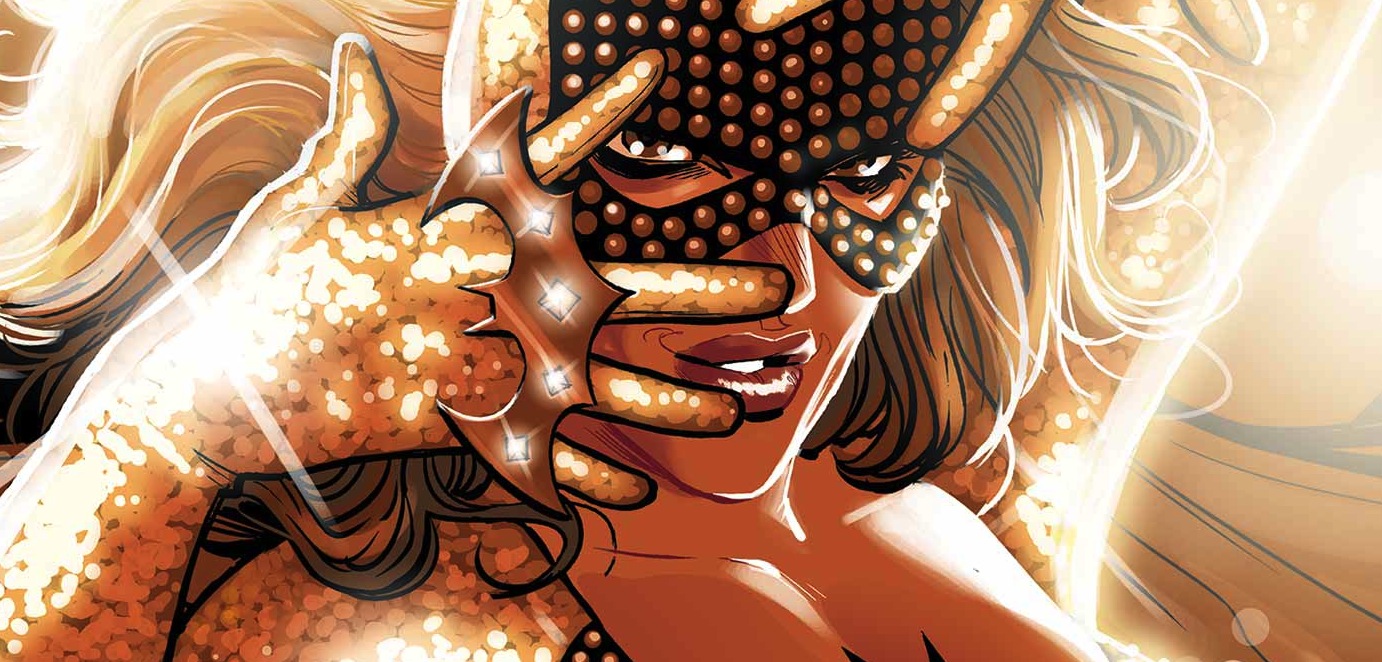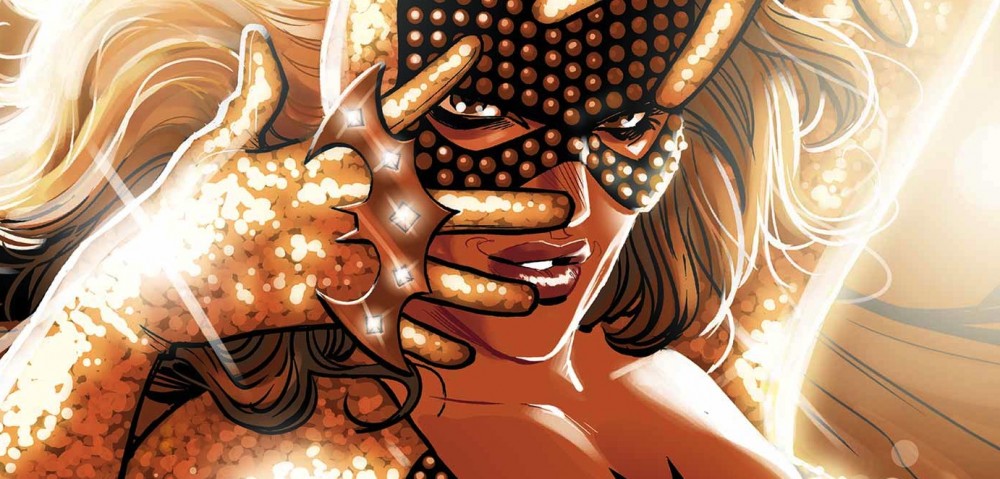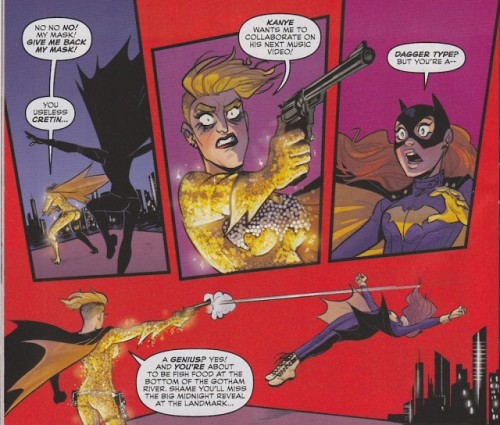This is obviously prefaced with a heaping helping of “what the hell does a straight white male know about these issues?”. The simple truth: I don’t know anything. I likely never will – or at least not in a way that can be internalized. At best, I can gather other people’s feelings and memories and keep them in my brain for reference, paging through as I react and respond, because… well, I might not know anything about this, but I think that reaction and response is important instead of choking the fire of discussion dead through inaction.
So. Batgirl #37.
The new creative team on Batgirl arrived with a certain amount of pomp and circumstance. Briefly bringing my experience as a retailer into the fray, the fervour was created almost entirely by the creative team themselves, and not the company publishing the book. A book lives on finding an audience and marketing to that audience, and while DC did eventually run a house ad steeped in current social media trends, it was the creative team that was actually out on social media sites stirring the fan base and building a culture. At the time, I remember thinking that this was something important – not only in the way the creatives were interacting with the fans, but in the way that the reaction seemed to transform into a small movement of sorts, one that would boost sales of a series through actual interest in tone and content. This week, it seems as though the shine is off that apple with the release of the team’s third issue, Batgirl #37.
In the issue, Barbara Gordon is confronted with another Batgirl, one that is using social media and various forms of “art” to essentially take her branding identity away from her. Over the course of the book, you discover that the person under this fake Batgirl’s mask is in fact Dagger Type, an artist who is identified by characters in the story as male. Babs is taken aback by this and is left defeated as the issue’s villain continues with their nefarious plan to steal her public identity.
As the book crescendos, Dagger Type is portrayed as erratic, firing a gun into a crowd of essentially innocent bystanders. Babs eventually defeats the villain, and discovers that they’ve been doing this at the behest of a mysterious benefactor. The cops take Dagger away, and the book draws to a close. This reading of Batgirl #37 has dredged up accusations of transphobia. As with all art, this is a valid interpretation of fictitious events – a reaction to substance informed by opinion, experience and information. That’s a shame because… well, this book was meant to be something else. As stated before, it was something different than the norm, and marketed to a different and potentially new audience, and this misfire will probably do some damage. The only consolation, I would think, is that despite this valid interpretation of the comic, it isn’t something done with malicious intent, more than it was the unfortunate side-effect of the story’s plot.
Revisiting the plot again, using the same reference material, the plot is also about the nature of art, identity, and belonging. The book opens with the fake Batgirl going on a crime spree. Babs shows up and stops the crime, but not the fake Batgirl, who is said to have been up to these types of heists and behaviours for quite some time, chronicling these events on social media platforms. Babs is upset that she’s being defamed, which is compounded when she goes to a Dagger Type art show that features nothing but pictures of this so-called Batgirl, complete with a rendition of the heroine in a wheelchair, splashed with shadow and a bright red overlay. The presentation effects the characters present in different ways. It strikes Babs as demeaning and regressive. She makes a move to find Dagger Type, and soon discovers that the artist has been the fake Batgirl all along. The plot involves using art and social media to co-opt the Batgirl brand, and add it to the Dagger Type cache. When the reveal happens, everyone in the audience acts dismissive. Dagger waxes poetic about how they should relish in this moment, where they “begin to comprehend that the artist is really the subject. And the subject, his brand!” This elicits the greatest reaction from the crowd, who rejects this notion with lines like “why does everything cool turn out to be an ad?”
The intention – or at least my interpretation of the events as described – is a comment on art and commercialism, as seen through the lens of the modern superhero genre. It’s an ugly balance that comic companies (and retailers… hi!) have been trying to work with for years, taking art and using it for commercial gains. It’s an exploration of the kind of rejection that occurs when false notes are struck, and the commercial ends up bleeding into the art. It’s also about the pretension of craving attention, and the effect popularity can have on art and the artist. There’s a lot to dig into there, but at the core of it all, deep down in the nugget, I truly believe this book is about art, and the reactions to it. It’s typified by the scene where Babs and her friends are walking through the Batgirl gallery, and they all have different reactions to the presentation based off of experience. Babs’ very personal experience with the identity being explored in these photos elicits a very personal and valid response. I can only imagine that’s what many people felt as they read through this issue and experienced a similarly flawed take on identity. The issue essentially agrees with the idea of interpretation being in the eye of the beholder, and never once says that people who enjoyed the art installation in the pages of the book are wrong. It does cast judgement on intent. Dagger Type’s intent was self serving to a cartoonish degree, climaxing in rage when people didn’t understand his genius. I don’t think the creative team is doing that here. I think they wanted to turn in a story that commented on what they did, letting the art speak for itself. It may have said something things they didn’t intend, but they aren’t mad at anyone for it – as the issue implies, any reaction to art is valid.
Now, not long after I wrote this article (but a long while before it’s been posted), Cameron Stewart, Brendan Fletcher and Babs Tarr issued an apology.
Batgirl 37. We made mistakes. We’re deeply sorry. We will do better. pic.twitter.com/fCOEJPk0vP
— Cameron Stewart (@cameronMstewart) December 13, 2014
I wish Cameron Stewart, Brenden Fletcher, Babs Tarr and Maris Wicks all the best as they continue to explore this character and produce art for us to consume. I hope that it continues to challenge us, and causes discussion. I hope that discussion comes from an honest place, and is not confronted with reductive reasoning. I also hope that, like all great artists, they will continue to grow and learn from previous experiences and new information, as even the best intentions can be flawed. The best artists take those noted flaws and learn to grow, instead of digging their heels in. These people are some of the best. Oh, and one more thing:
If you didn’t think an apology was needed, the apology wasn’t for you.
— Cameron Stewart (@cameronMstewart) December 13, 2014










“what the hell does a straight white male know about these issues” Don’t let that qualifier stop you, right?
Let’s not have The Beat venture into the realm of mansplaining when it comes to trans issues. Are straight white cis-gendered males capable of bringing thoughtful insight to a civil rights issue? Yes. Is there literally anyone else more qualified? Absolutely.
When it comes to lifting voices on LGBT issues, maybe we can hear from those voices instead of someone else speaking for us.
Come on now, Chris, there was no need to force the “cis-gendered” label on him. But your comment raises some excellent points.
If a transgender or gay man speaks condescendingly, can it be considered “mansplaining,” or is that term reserved exclusively for straight white (cis-gendered) males? For that matter, when straight white cis-gendered females speak on LGBT issues, are they also, in effect, “mansplaining”???
Chris Williams: Agreed. I will note that I volunteered this article without prompting, so that’s all on me, and not Heidi or anyone else here at The Beat. I’m definitely not going to have the best perspective on this issue – but for a lot of people, I will remain the cultural touchpoint for it – and not because I wrote the article, but because I’m their comics retailer. This comic has come up, and will continue to come up, and unfortunately, I’m going to be the person a good chunk of people will talk to. This isn’t about talking over more important and relevant voices, but circumstance and, I think, personal responsibility to my customers, as I feel as though silence on the issue would be more damning than speaking, in this instance.
The idea that he can’t even publish an article is ridiculous.
I don’t even think this character was trans.
Were people getting upset? Is the issue so touchy that we have to be this careful? I mean… if we follow the same logic to other things, shouldn’t computer hackers get “upset” every time they are misrepresented as bad guys looking to take down “the system?”
If that’s the case, maybe we need some cool transgender comics to balance things out — so that the only time it comes up is as bad guy — I think if things were more balanced — things like this wouldn’t be noticed as much? Computer hackers are represented a variety of ways, so when one is untrue – or shows as a bad guy – it doesn’t “sting” as much – because it’s not the only representation.
Thoughts?
This story needed an apology from the creators. They obviously didn’t think it all the way through, like article writer Brandon Schatz has explained. While some will complain of political correctness hampering creative indulgences or even society at large, the fact is when you take a minority and demonize it , especially while a larger battle in society about said subject is going on, you are being stupid and/or a total jerk. Plain and simple. It’s surprising though considering how this comic was seemingly so socially aware. Guess not.
This wasn’t demonizing trans people. The character dressed up like Batgirl and do villainous things while wearing the costume to make her look bad.
I like how in this age and day its okay to maim, kill and ridicule straight white male characters but god forbid if you’ll do anything negative to any other character.
What happened to comics simply being about story told thru art and words?
They have nothing to apologize for.
If you also didn’t think an apology was necessary, then you are correct.
Unless Cameron Stewart is apologizing for being a secret transphobe, he didn’t need to issue an apology.
Furthermore, I’m tired of people thinking I’m smart just because I wear glasses.
STOP PREJUDICE NOW!!!!
“I like how in this age and day its okay to maim, kill and ridicule straight white male characters but god forbid if you’ll do anything negative to any other character.”
That’s because there are literally thousands of straight white heroes to balance having straight white villains. There are only a handful of LGBT heroes as opposed to the centuries worth of LGBT characters being cast as villains, both in stories and in real life. It’s still part of the whole “Look at him! He’s dressed as a woman! Isn’t he crazy?!” narrative.
Yeah, but — I mean — was he a Transgender? Or just some guy dressed as a girl up to nefarious purposes — I mean, there is a difference, right?
Actually, if he/she was a transgender – should refer to as “she.” But you get my point. Anyone?
@Kilroy, so are we going to treat all female and minority characters like sacred cows now till it “balances out”? I always thought that path to equality is to stop treating some specific group(s) as special.
Either way I’m reading specific issue of specific comic book title, why does it matter that there are lots of white characters and not many LGBT characters? It doesn’t make story stronger or weaker in any sense. As I said, comics aren’t about story told by art and words anymore, now you have to “balance things” and try to be politically correct. Its ridiculous that creative team has to apologize for making good Batgirl issue, because it didn’t portray LGBT character in positive light. After all story didn’t even acknowledge Dagger Type as LGBT character, he was just wearing variant of Batgirl’s costume.
If characters of a minority group have a history of being portrayed negatively, then it would be worth questioning whether it’d be good to add to this portrayal. So, within the portrayal of the minority it IS about balance. For example, if there’s a historical and current tendency to portray Islamic people as fundamentalists/terrorists, adding another muslim on a Jihad is not adding diversity.
I haven’t read this Batgirl comic, but I think Transgender, but even more so crossdressing characters have a habit of being portrayed as “unhinged men”. We don’t need another one of those.
That this character is not just a bloke dressed up as Batgirl to make her look bad, but was intended as a Transvestite or crossdressing person can be seen by the make-up: while you can still argue that the lipstick is done as part of the masquerade, the eye make-up would not have been necessary under the mask…
All this is not to say that there can’t be any baddies in minority groups, but any writer/artist would do well to avoid stereotypes and clichés, and to ensure that hero characters who should have an understanding about minorities also show this: Babs will have met with prejudice when she had a disability, so one can assume expect a more open mind from her.
Those who cry about PC Gone Mad and such should perhaps look at life from the pov of minorities before crying.
@Remco – I’m right there with ya. This isn’t about whether or not a trans character or a cross-dressing character is able to be a villain; of course they can. It’s about this representation joining the chorus of negative portrayals for those minority groups. While I get some people’s reaction that you can’t lay that all at the feet of this creative team; it’s certainly still worth discussing, right?
@Dylan Campbell – I think that’s what the heart of this discussion should be about. Not just how this creative team or this one comic represented trans characters, but how trans characters are represented (or not represented) overall. If any time I see a character that happens to fall within a certain subset of people, they happen to be the villain? That raises questions not just about how we view the character, but also the subset they belong to.
Anyone remember, back in the 90s, when DC had a cosplayer (then known as “hall costumes”) kicked out of the Chicago Comic Con because he was dressed as Catwoman?
Hmm… two of the best known secret-gender-identity characters are owned by DC Comics:
Ma Hunkel and Madam Fatal.
Has anyone used the theme of secret superhero identity and secret sexual identity to tell a good story?
(Maybe Astro City v.3.16?)
Anyone care to post links to transgendered or cross-dressing heroes in the Golden Age?
A character doesn’t need to be transgendered for a scene to be transphobic.
A lot of the issues with the scene are collected and dissected here by Andrew Wheeler, and I suggest all go and read that as well: http://comicsalliance.com/batgirl-37-criticized-for-transphobic-content-creative-team-apologizes/
Look at all these straight people explaining trans issues!
All of you need to go read a book (here’s a helpful tip, stop using transgender as a noun). Now go forth, and educate yourself. Listen to the voices of those who live through this stuff every day. Stop presuming that your opinion on this comic is more valid than those offended or hurt by it. Holy shit, people.
Your condescending post belies you actually wanting to ‘educate’.
But I don’t really agree with that either, Chris Williams.
Nowhere did I claim that my opinion would be of more value than those who live through this stuff every day (though I know about inequality, discrimination, being a minority, etc).
Neither do I claim that about being black in the USA. But I feel that by speaking out against the injustice carried out against Mike Brown and Tamir Rice I add weight to the side that says: No!
Just like I believe that the trans community can do with sympathetic voices and friends.
(Of course, if you were only taking people to task who from their cozy cis corner felt that no apology from the creators was needed- well, I agree with you there).
@Chris Williams – You’re just trolling, right? You just gotta be. Can only transgender folks talk about the issue? Really? Nah, you gotta be trolling.
“As with all art, this is a valid interpretation of fictitious events – a reaction to substance informed by opinion, experience and information.”
That’s quite a statement there. ANY interpretation of art is valid? Really? ANY interpretation? Even interpretations that seem willfully ignorant of basic elements of the plot in question?
Because that’s what the outrage over this issue was: a reactionary outrage from people who didn’t understand that the character wasn’t transgender in the first place.
The character is referred to as “he”. He refers to himself as “he”. I’m not sure how Cameron Stewart could have done anything more to alert readers that, hey, this character doesn’t identify as a trans woman.
And yet some readers still took huge offense to this simply because they’re poor readers in the first place? That’s their own damn fault.
“This is obviously prefaced with a heaping helping of “what the hell does a straight white male know about these issues?”. The simple truth: I don’t know anything. I likely never will – or at least not in a way that can be internalized.”
Okay, I see what you’re saying there, but… you do know about logic, right? Like, on some level, many things are either logical or they’re not, and it doesn’t matter what someone’s skin color or gender or sexuality is, certain things are obviously true. Like, 2 plus 2 is 4, and Dagger Type is not a transsexual woman.
@Hufnagel0, sadly no. If I was trolling, I would be hiding behind a fake username and avatar. I’m quite serious, and I’m quite public about it as well.
The past couple of days, I’ve read comments littered with ignorance, transphobia, and an incredible lack of empathy. After my initial comment about lifting up LGBT voices, I was “corrected” by a bunch of straight people. You only need remedial comprehension to understand the how preposterous that is.
@Remco, I get your point. I think there is a big difference between people of all colors standing up for patently gross injustices to this. There is room for nuance. We’re not getting any of that here.
Yesterday, Brandon Schatz stated on Twitter that he agrees there needs to have more perspective and would update this post to bring those perspectives to this post. Reading these comments, I doubt they would have the much needed impact required.
The transphobic trope of men doing evil deeds dressed as women has been used over and over. It’s offensive. YOU don’t have to be offended by it. YOU may go on your merry way expressing just how much you aren’t offended by it. You’re opinion of it doesn’t somehow by virtue of being yours make other opinions less valid. Like Stewart said, if you aren’t offended by it, then his apology isn’t for you.
I’m tired of trying to explain the importance of this. Buy a copy of this issue, give it your your transgender friend, and start a dialog with them. But don’t get your LGBT culture cues from here. They’re not represented.
Over 200 trans people, one in twelve, are murdered every year. Transphobic representation in media absolutely fuels that fire. You can complain about criticism all you want but that has zero effect on your life. Meanwhile we are attacked amd killed in the street for simply existing. I think that might be a bit more important, hmm?
That’s really immaterial to this. People reading this run of Batgirl aren’t going to go out there and kill Trans people.
“Over 200 trans people, one in twelve, are murdered every year.”
If 200 was one in twelve, that would mean that there are only 2400 trans people in the world. The last study I saw suggested a bit under one million in the United States alone.
“Transphobic representation in media absolutely fuels that fire.”
Is there any data that supports this? I tend to be leery of unsourced claims about media causing people to behave a certain way.
“You’re opinion of it doesn’t somehow by virtue of being yours make other opinions less valid.”
I couldn’t have said it better myself.
Comments are closed.